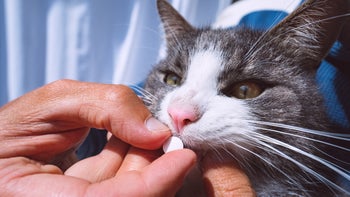
No, Cats Cannot Eat Chocolate. Here’s Why.
Key takeaways:
Chocolate contains toxic substances like theobromine and caffeine that cats can’t metabolize.
Even a small amount of chocolate can cause serious health issues for cats.
If your cat eats chocolate, contact your vet immediately. Don’t wait for symptoms to appear before reaching out for help.
Table of contents

You likely already know that chocolate is toxic to dogs. But what about their feline counterparts? Can cats eat chocolate?
While it may be tempting to share a piece of a chocolate bar with your kitty, chocolate is an extremely dangerous food for cats. Pet owners need to understand why this sweet treat poses such a threat and what to do if your cat accidentally ingests any.
Why is chocolate bad for cats?
Chocolate contains two key substances that are harmful to cats: theobromine and caffeine. Both are stimulants that cats can’t metabolize properly. In humans, these ingredients can have mild effects, such as a boost of alertness or energy. However, in cats, they can lead to toxic buildup in the system, resulting in serious health problems.
Search and compare options
“These substances are stimulants that cats' livers can’t metabolize efficiently,” Veronica Villanueva, DVM, medical director at VEG Anaheim Hills, told GoodRx. “These compounds can cause harmful reactions in their body and lead to chocolate poisoning.”
This means that even small amounts of chocolate can overwhelm a cat's system. The concentration of theobromine varies by the type of chocolate. Darker chocolates and concentrates contain significantly higher levels than milk or white chocolate. That’s not to say, however, that these don’t still pose a danger to your cat.
Here are the most to least dangerous types of chocolate for cats:
Cocoa powder: highest levels of theobromine
Baking chocolate: also highly toxic due to concentrated theobromine
Dark chocolate: highest toxicity of the three most common types eaten (dark, milk, and white)
Milk chocolate: less toxic but still harmful
White chocolate: contains little theobromine, but its high sugar and fat content can cause digestive upset
Can chocolate kill cats?
Yes, chocolate can be fatal to cats if eaten in large amounts.
“The severity of the poisoning depends on the type of chocolate, the amount consumed, and the size and health of your cat,” explained Joanna Herberger, DVM. Dark chocolate and baking chocolate, as mentioned above, pose the highest risks due to their higher concentrations of theobromine.
In severe cases, chocolate toxicity can lead to dangerous symptoms like seizures, collapse, and heart arrhythmias. Villanueva warned that “chocolate, especially in large amounts, can lead to fatal consequences such as severe heart issues or even organ shutdown.”
More toxic foods: Chocolate isn’t the only treat that’s harmful to cats. Here’s a list of 11 foods that can make your kitty sick.
Teeth cleaning: These step-by-step instructions can help you brush your cat’s teeth at home.
Feeling groovy: Catnip can put many cats in a good mood. Plus, it can reduce stress and repel bugs. Here’s what you need to know about catnip.
How much chocolate is too much for a cat?
When it comes to chocolate and cats, there’s no safe amount. The exact amounts that are toxic depend on factors like the type of chocolate, the size of your cat, and how much they ate.
Herberger explained, “Any amount of chocolate is harmful to your cat. But cocoa powder, dark chocolate, and baking chocolate contain the highest levels of theobromine and pose the greatest risks.”
Villanueva broke it down into specifics. “As little as 20 mg of theobromine per pound of body weight can cause mild symptoms, and over 100 mg per pound can be potentially lethal.”
Read more like this
Explore these related articles, suggested for readers like you.
For reference, dark chocolate contains about 150 mg of theobromine per ounce, while white chocolate has only 1 mg per ounce.
When in doubt, pet parents can use a chocolate toxicity calculator to learn the effects of each type of chocolate based on their pet’s weight and the exact amount ingested.
What happens when a cat eats chocolate?
When a cat eats chocolate, the toxic substances — theobromine and caffeine — are absorbed into their bloodstream and interfere with normal heart and nervous system functions.
“At lower doses, a cat might experience vomiting, diarrhea, and rapid breathing,” said Herberger. “In more extreme cases, chocolate can trigger irregular heart rhythms or seizures.”
The severity of symptoms highly depends on the type and amount of chocolate consumed, as well as the size and health of the cat.
Signs of chocolate poisoning in cats
The signs of chocolate poisoning in cats usually appear within a few hours and can include a variety of symptoms, such as:
Vomiting
Diarrhea
Fever
Rapid breathing or panting
Tremors or muscle rigidity
Increased heart rate
Increased thirst or urination
Low blood pressure
“Hyperactivity and tremors are often among the first signs,” Villanueva warned. “Cats might seem unusually restless or be overly tense or rigid, which could quickly escalate to more severe symptoms.”
In extreme cases, chocolate poisoning in cats can lead to death if left untreated.
What to do if your cat eats chocolate
If you think your cat has eaten chocolate, don’t wait for symptoms to appear. Immediate action can be the difference between a mild case of poisoning and a life-threatening situation. Herberger urged that “prompt action is crucial.”
Here are the steps you should take if your cat eats chocolate:
Seek immediate veterinary care. Your vet may have you contact an animal poison control hotline or go straight to an emergency animal hospital.
Determine the amount and type of chocolate your cat ate. This will help your vet assess the level of toxicity they’re dealing with. Dark or baking chocolate is far more dangerous than milk chocolate.
Don’t try to treat it at home without guidance from a vet. Your veterinarian should be the only one administering care unless they’ve specifically told you otherwise.
Treatment at a veterinary clinic or hospital for chocolate poisoning in cats may include:
Induced vomiting
Activated charcoal to prevent further absorption
IV fluids to help flush toxins from the body
Seizure medications
Beta blockers
Nausea medications
The bottom line
Chocolate is highly toxic to cats. Even small amounts can cause significant health issues, such as vomiting, diarrhea, and seizures.
The severity of poisoning depends on the type of chocolate and the size of your cat. Dark chocolate, for instance, is more toxic than white or milk chocolate. But it’s best to assume any amount of chocolate consumption is a medical emergency.
If your cat eats chocolate (or you suspect they did), seek veterinary help immediately to avoid serious complications.
Why trust our experts?



References
Bigler-Coyne, A. (2020). The chemistry of chocolate. National Institute of General Medical Sciences.
Brooks, W. (2023). Chocolate toxicity in dogs. Veterinary Partner.
Hayes, C. Chocolate toxicosis in animals. Merck Veterinary Manual.
Keller, N. (2014). Household toxins: Dogs and cats. Veterinary Information Network.
Merck Veterinary Manual. (n.d.). Methylxanthine content of various types of chocolate.
MSD Veterinary Manual. (n.d.). Chocolate toxicity.
Pet Poison Helpline. (n.d.). Caffeine.
Pet Poison Helpline. (n.d.). Signs of chocolate poisoning in cats.





























